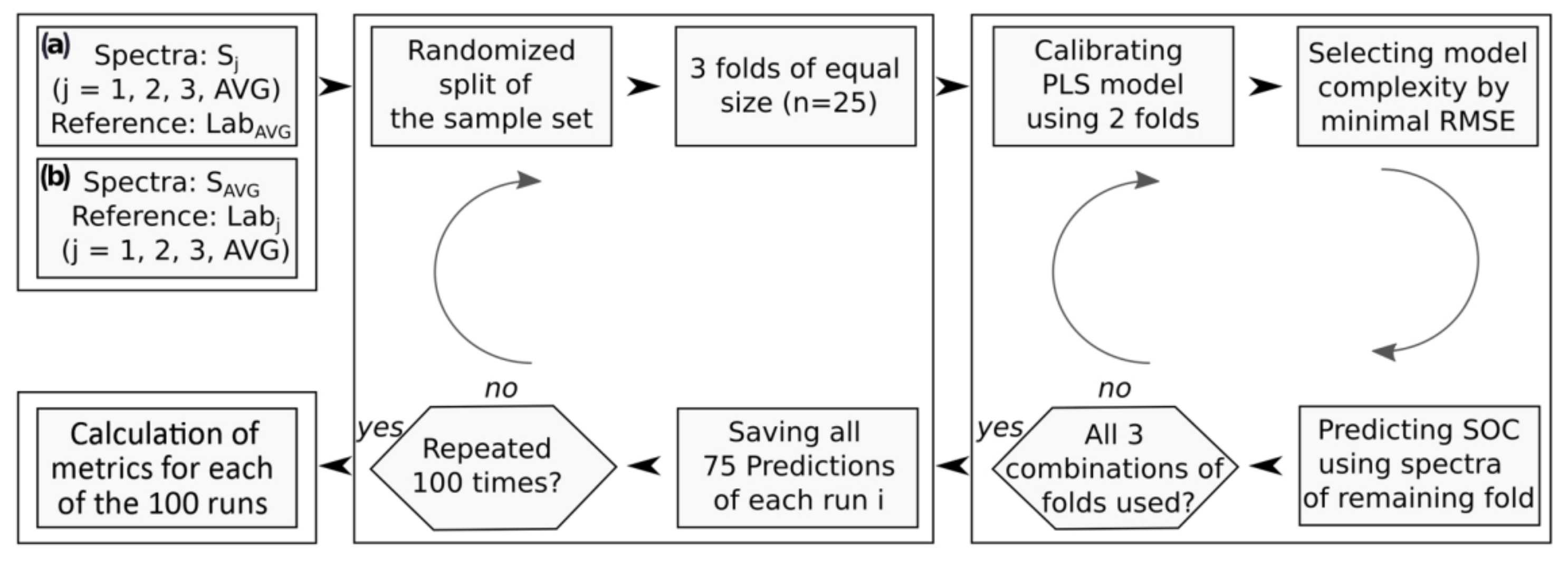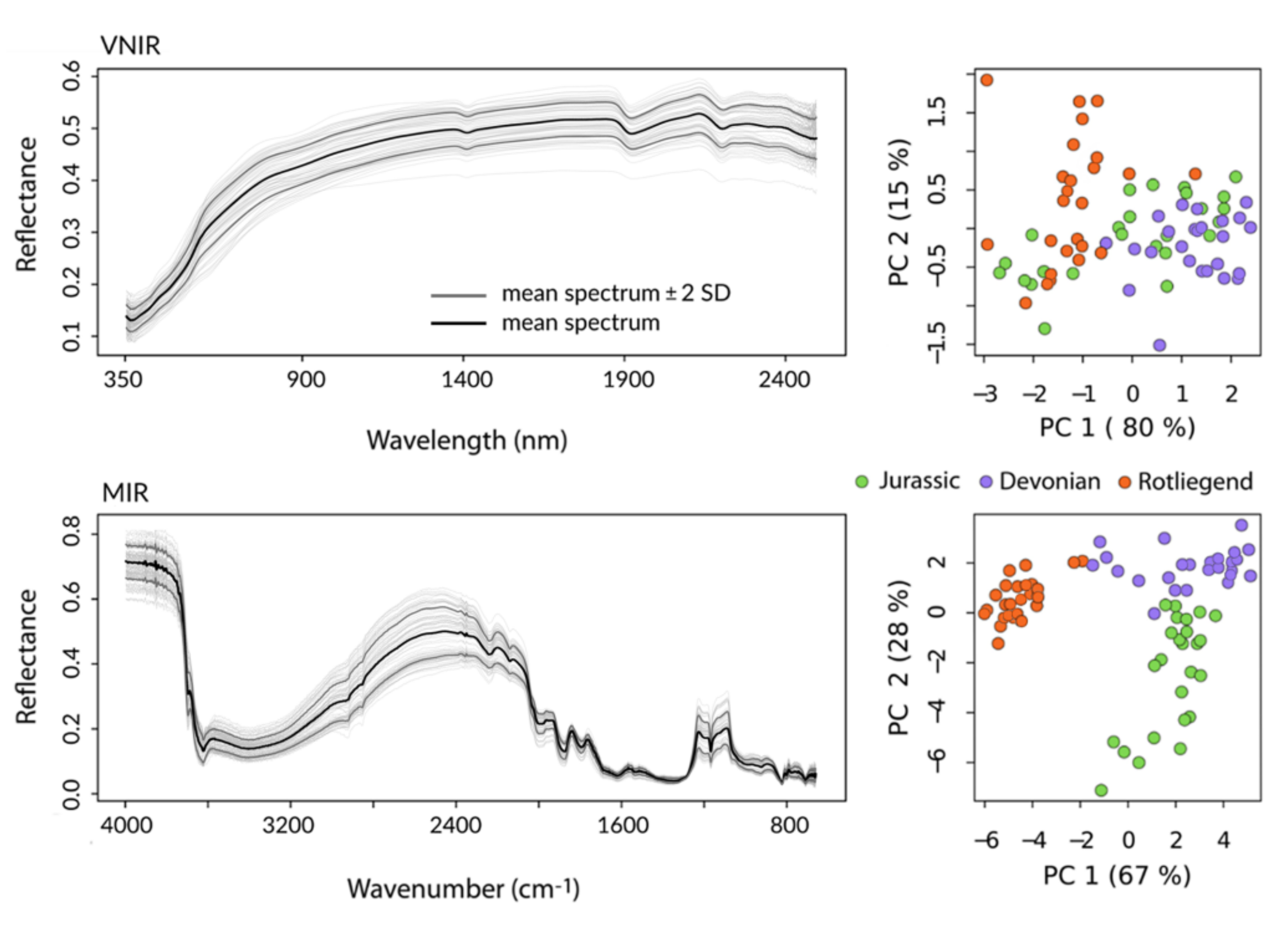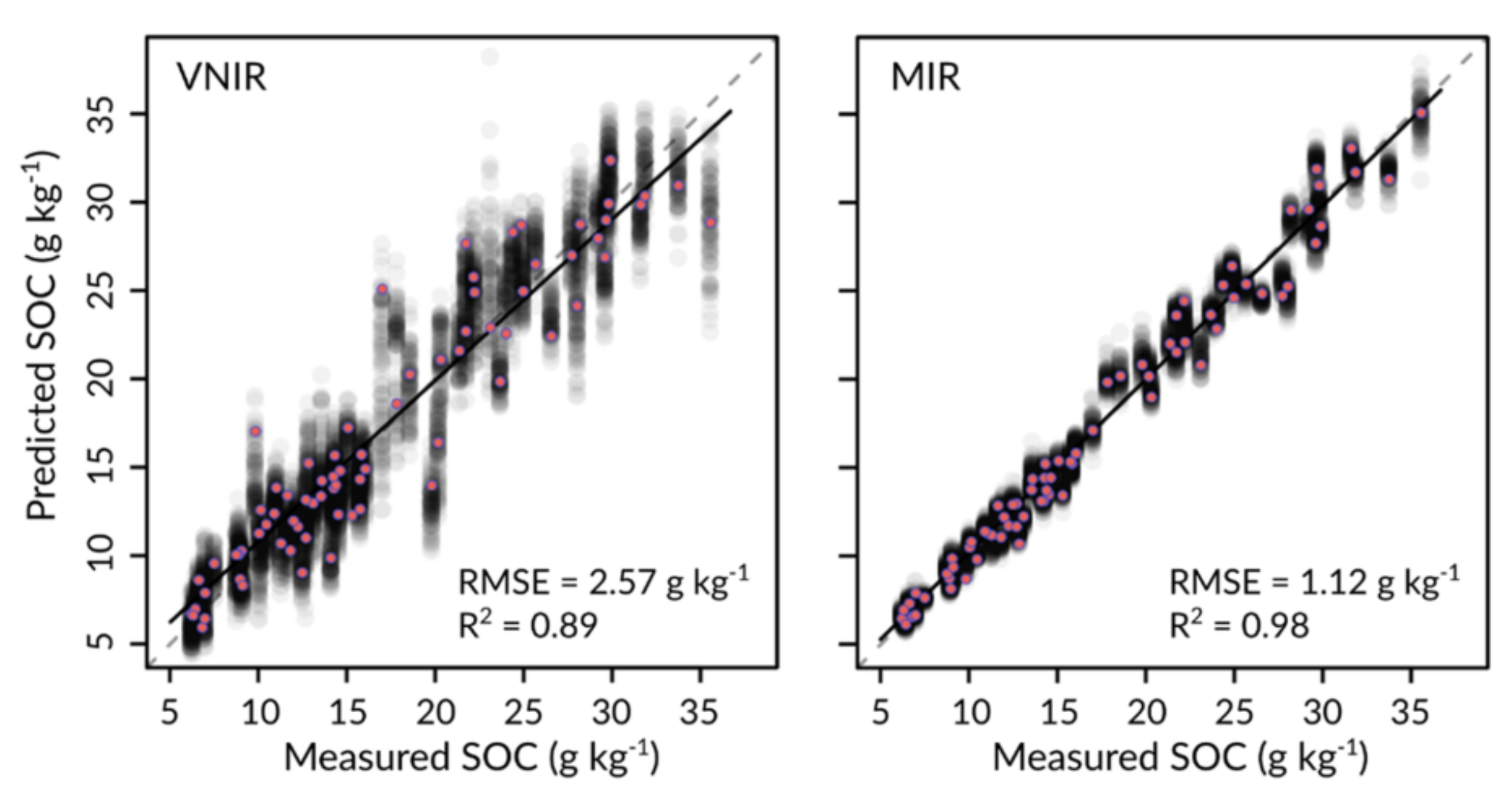Accuracy and Reproducibility of Laboratory Diffuse Reflectance Measurements with Portable VNIR and MIR Spectrometers for Predictive Soil Organic Carbon Modeling
Abstract
:1. Introduction
2. Materials and Methods
2.1. Soil Sampling and Pre-Treatment
2.2. Laboratory-Analytical Determination of SOC
2.3. VNIR and MIR Soil Reflectance Measurements
2.4. Evaluating Uncertainties in Analytical and Spectroscopic Measurements
2.5. Examining the Influence of Uncertainties on SOC Modeling Results
3. Results
3.1. Comparison of Analytical SOC Measurements by Dry Combustion
3.2. Evaluation of VNIR and MIR Reflectance Measurements
3.3. Accuracy of Predictive VNIR and MIR Models
3.4. Impacts of Spectral Variability and SOC Reference Data on Validation Accuracy
4. Discussion
5. Conclusions
Author Contributions
Funding
Institutional Review Board Statement
Informed Consent Statement
Data Availability Statement
Acknowledgments
Conflicts of Interest
References
- Barra, I.; Haefele, S.M.; Sakrabani, R.; Kebede, F. Soil spectroscopy with the use of chemometrics, machine learning and pre-processing techniques in soil diagnosis: Recent advances–A review. TrAC Trends Anal. Chem. 2020, 135, 116166. [Google Scholar] [CrossRef]
- Forrester, S.T.; Janik, L.J.; Soriano-Disla, J.M.; Mason, S.; Burkitt, L.; Moody, P.; Gourley, C.J.P.; McLaughlin, M.J. Use of handheld mid-infrared spectroscopy and partial least-squares regression for the prediction of the phosphorus buffering index in Australian soils. Soil Res. 2015, 53, 67. [Google Scholar] [CrossRef]
- Soriano-Disla, J.M.; Janik, L.J.; Allen, D.J.; McLaughlin, M.J. Evaluation of the performance of portable visible-infrared instruments for the prediction of soil properties. Biosyst. Eng. 2017, 161, 24–36. [Google Scholar] [CrossRef]
- Hutengs, C.; Ludwig, B.; Jung, A.; Eisele, A.; Vohland, M. Comparison of Portable and Bench-Top Spectrometers for Mid-Infrared Diffuse Reflectance Measurements of Soils. Sensors 2018, 18, 993. [Google Scholar] [CrossRef] [Green Version]
- Hutengs, C.; Seidel, M.; Oertel, F.; Ludwig, B.; Vohland, M. In situ and laboratory soil spectroscopy with portable visible-to-near-infrared and mid-infrared instruments for the assessment of organic carbon in soils. Geoderma 2019, 355, 113900. [Google Scholar] [CrossRef]
- Janik, L.J.; Soriano-Disla, J.M.; Forrester, S.T. Feasibility of handheld mid-infrared spectroscopy to predict particle size distribution: Influence of soil field condition and utilisation of existing spectral libraries. Soil Res. 2020, 58, 528. [Google Scholar] [CrossRef]
- O’Rourke, S.M.; Holden, N.M. Optical sensing and chemometric analysis of soil organic carbon—a cost effective alternative to conventional laboratory methods? Soil Use Manag. 2011, 27, 143–155. [Google Scholar] [CrossRef]
- Seybold, C.A.; Ferguson, R.; Wysocki, D.; Bailey, S.; Anderson, J.; Nester, B.; Schoeneberger, P.; Wills, S.; Libohova, Z.; Hoover, D.; et al. Application of Mid-Infrared Spectroscopy in Soil Survey. Soil Sci. Soc. Am. J. 2019, 83, 1746–1759. [Google Scholar] [CrossRef]
- Difoggio, R. Examination of Some Misconceptions about Near-Infrared Analysis. Appl. Spectrosc. 1995, 49, 67–75. [Google Scholar] [CrossRef]
- Faber, K.; Kowalski, B.R. Improved Prediction Error Estimates for Multivariate Calibration by Correcting for the Measurement Error in the Reference Values. Appl. Spectrosc. 1997, 51, 660–665. [Google Scholar] [CrossRef]
- Difoggio, R. Guidelines for Applying Chemometrics to Spectra: Feasibility and Error Propagation. Appl. Spectrosc. 2000, 54, 94A–113A. [Google Scholar] [CrossRef]
- Ellinger, M.; Merbach, I.; Werban, U.; Ließ, M. Error propagation in spectrometric functions of soil organic carbon. SOIL 2019, 5, 275–288. [Google Scholar] [CrossRef] [Green Version]
- Kuester, M.; Thome, K.; Krause, K.; Canham, K.; Whittington, E. Comparison of surface reflectance measurements from three ASD FieldSpec FR spectroradiometers and one ASD FieldSpec VNIR spectroradiometer. In Proceedings of the IGARSS 2001. Scanning the Present and Resolving the Future. Proceedings. IEEE 2001 International Geoscience and Remote Sensing Symposium (Cat. No.01CH37217), Sydney, NSW, Australia, 9–13 July 2001; IEEE: Piscataway, NJ, USA, 2001; pp. 72–74, ISBN 0-7803-7031-7. [Google Scholar]
- Martínez-España, R.; Bueno-Crespo, A.; Soto, J.; Janik, L.J.; Soriano-Disla, J.M. Developing an intelligent system for the prediction of soil properties with a portable mid-infrared instrument. Biosyst. Eng. 2019, 177, 101–108. [Google Scholar] [CrossRef]
- Wehrle, R.; Welp, G.; Pätzold, S. Total and Hot-Water Extractable Organic Carbon and Nitrogen in Organic Soil Amendments: Their Prediction Using Portable Mid-Infrared Spectroscopy with Support Vector Machines. Agronomy 2021, 11, 659. [Google Scholar] [CrossRef]
- Aastveit, A.H.; Marum, P. On the Effect of Calibration and the Accuracy of NIR Spectroscopy with High Levels of Noise in the Reference Values. Appl. Spectrosc. 1991, 45, 109–115. [Google Scholar] [CrossRef]
- Stevens, A.; Nocita, M.; Tóth, G.; Montanarella, L.; van Wesemael, B. Prediction of Soil Organic Carbon at the European Scale by Visible and Near InfraRed Reflectance Spectroscopy. PLoS ONE 2013, 8, e66409. [Google Scholar] [CrossRef] [PubMed]
- Faber, K.; Kowalski, B.R. Propagation of measurement errors for the validation of predictions obtained by principal component regression and partial least squares. J. Chemometr. 1997, 11, 181–238. [Google Scholar] [CrossRef]
- Geologie von Rheinland-Pfalz; Landesamt für Geologie und Bergbau Rheinland-Pfalz; Schweizerbart: Stuttgart, Germany, 2005; ISBN 9783510652150.
- Wagner, W.H.; Kremb-Wagner, F.; Koziol, M.; Negendank, J.F.W. Trier und Umgebung: Geologie der Süd- und Westeifel, des Südwest-Hunsrück, der Unteren Saar Sowie der Maarvulkanismus und die Junge Umwelt- und Klimageschichte; Borntraeger: Stuttgart, Germany, 2012; ISBN 9783443150945. [Google Scholar]
- Ortner, M.; Seidel, M.; Semella, S.; Udelhoven, T.; Vohland, M.; Thiele-Bruhn, S. Content of soil organic carbon and labile fractions depend on local combinations of mineral-phase characteristics. SOIL 2022, 8, 113–131. [Google Scholar] [CrossRef]
- DIN ISO 10694; Soil Quality-Determination of Organic and Total Carbon after Dry Combustion (Elementary Analysis). Beuth Verlag: Berlin, Germany, 1996.
- Chatterjee, A.; Lal, R.; Wielopolski, L.; Martin, M.Z.; Ebinger, M.H. Evaluation of Different Soil Carbon Determination Methods. Crit. Rev. Plant Sci. 2009, 28, 164–178. [Google Scholar] [CrossRef]
- Kuhn, M.; Johnson, K. Applied Predictive Modeling; Springer: New York, NY, USA, 2013; ISBN 1461468485. [Google Scholar]
- R Core Team. R: A Language and Environment for Statistical Computing; R Foundation for Statistical Computing: Vienna, Austria, 2020. [Google Scholar]
- Liland, K.; Mevik, R.; Wehrens, R.; Hiemstra, P. pls: Partial Least Squares and Principal Component Regression. R Package Version 2.8-0. 2021. Available online: https://CRAN.R-project.org/package=pls (accessed on 30 September 2021).
- Stevens, A.; Ramirez-Lopez, L.; Guillaume, H. prospectr: Miscellaneous Functions for Processing and Sample Selection of Spectroscopic Data. R Package Version 0.2.1. 2020. Available online: https://CRAN.R-project.org/package=prospectr (accessed on 31 October 2020).
- Munzert, M.; Kießling, G.; Übelhör, W.; Nätscher, L.; Neubert, K.H. Expanded measurement uncertainty of soil parameters derived from proficiency-testing data. J. Plant Nutr. Soil Sc. 2007, 170, 722–728. [Google Scholar] [CrossRef]
- Ross, D.S.; Bailey, S.W.; Briggs, R.D.; Curry, J.; Fernandez, I.J.; Fredriksen, G.; Goodale, C.L.; Hazlett, P.W.; Heine, P.R.; Johnson, C.E.; et al. Inter-laboratory variation in the chemical analysis of acidic forest soil reference samples from eastern North America. Ecosphere 2015, 6, 73. [Google Scholar] [CrossRef]
- Miltz, J.; Don, A. Optimising Sample Preparation and near Infrared Spectra Measurements of Soil Samples to Calibrate Organic Carbon and Total Nitrogen Content. J. Near Infrared Spec. 2012, 20, 695–706. [Google Scholar] [CrossRef]
- Nduwamungu, C.; Ziadi, N.; Tremblay, G.F.; Parent, L. Near-Infrared Reflectance Spectroscopy Prediction of Soil Properties: Effects of Sample Cups and Preparation. Soil Sci. Soc. Am. J. 2015, 73, 1896–1903. [Google Scholar] [CrossRef]
- Stumpe, B.; Weihermüller, L.; Marschner, B. Sample preparation and selection for qualitative and quantitative analyses of soil organic carbon with mid-infrared reflectance spectroscopy. Eur. J. Soil Sci. 2011, 62, 849–862. [Google Scholar] [CrossRef]
- Le Guillou, F.; Wetterlind, W.; Viscarra Rossel, R.A.; Hicks, W.; Grundy, M.; Tuomi, S. How does grinding affect the mid-infrared spectra of soil and their multivariate calibrations to texture and organic carbon? Soil Res. 2015, 53, 913. [Google Scholar] [CrossRef]
- Reeves, J., III; McCarty, G.; Mimmo, T. The potential of diffuse reflectance spectroscopy for the determination of carbon inventories in soils. Environ. Pollut. 2002, 116, S277–S284. [Google Scholar] [CrossRef]
- Wijewardane, N.K.; Ge, Y.; Sanderman, J.; Ferguson, R. Fine grinding is needed to maintain the high accuracy of MIR spectroscopy for soil property estimation. Soil Sci. Soc. Am. J. 2020, 85, 263–272. [Google Scholar] [CrossRef]
- Da Fonseca, A.A.; Pasquini, C.; Costa, D.C.; Soares, E.M.B. Effect of the sample measurement representativeness on soil carbon determination using near-infrared compact spectrophotometers. Geoderma 2022, 409, 115636. [Google Scholar] [CrossRef]
- Vohland, M.; Ludwig, M.; Thiele-Bruhn, S.; Ludwig, B. Determination of soil properties with visible to near- and mid-infrared spectroscopy: Effects of spectral variable selection. Geoderma 2014, 223–225, 88–96. [Google Scholar] [CrossRef]
- Stenberg, B.; Viscarra Rossel, R.A.; Mouazen, A.M.; Wetterlind, J. Visible and Near Infrared Spectroscopy in Soil Science; Elsevier: Amsterdam, The Netherlands, 2010; pp. 163–215. ISBN 9780123810335. [Google Scholar]
- Soriano-Disla, J.M.; Janik, L.J.; Viscarra Rossel, R.A.; Macdonald, L.M.; McLaughlin, M.J. The perfomance of visible, near-, and mid-infrared reflectance spectroscopy for prediction of soil physical, chemical, and biological properties. Appl. Spectrosc. Rev. 2014, 49, 139–186. [Google Scholar] [CrossRef]
- Reeves, J.B. Near-versus mid-infrared diffuse reflectance spectroscopy for soil analysis emphasising carbon and laboratory versus on-site analysis: Where are we and what needs to be done? Geoderma 2010, 158, 3–14. [Google Scholar] [CrossRef]
- Greenberg, I.; Seidel, M.; Vohland, M.; Koch, H.J.; Ludwig, B. Performance of in situ vs. laboratory mid-infrared soil spectroscopy using local and regional calibration strategies. Geoderma 2022, 409, 115614. [Google Scholar] [CrossRef]
- Hutengs, C.; Eisenhauer, N.; Schädler, M.; Lochner, A.; Seidel, M.; Vohland, M. VNIR and MIR spectroscopy of PLFA-derived soil microbial properties and associated physicochemical soil characteristics in an experimental plant diversity gradient. Soil Biol. Biochem. 2021, 160, 108319. [Google Scholar] [CrossRef]
- Bellon-Maurel, V.; McBratney, A. Near-infrared (NIR) and mid-infrared (MIR) spectroscopic techniques for assessing the amount of carbon stock in soils—Critical review and research perspectives. Soil Biol. Biochem. 2011, 43, 1398–1410. [Google Scholar] [CrossRef]
- Angelopoulou, T.; Balafoutis, A.; Zalidis, G.; Bochtis, D. From Laboratory to Proximal Sensing Spectroscopy for Soil Organic Carbon Estimation—A Review. Sustainability 2020, 12, 443. [Google Scholar] [CrossRef] [Green Version]
- Vohland, M.; Ludwig, B.; Seidel, M.; Hutengs, C. Quantification of soil organic carbon at regional scale: Benefits of fusing vis-NIR and MIR diffuse reflectance data are greater for in situ than for laboratory-based modelling approaches. Geoderma 2022, 405, 115426. [Google Scholar] [CrossRef]
- Viscarra Rossel, R.A.; Walvoort, D.J.J.; McBratney, A.B.; Janik, L.J.; Skjemstad, J.O. Visible, near infrared, mid infrared or combined diffuse reflectance spectroscopy for simultaneous assessment of various soil properties. Geoderma 2006, 131, 59–75. [Google Scholar] [CrossRef]
- Hong, Y.; Munnaf, M.A.; Guerrero, A.; Chen, S.; Liu, Y.; Shi, Z.; Mouazen, A.M. Fusion of visible-to-near-infrared and mid-infrared spectroscopy to estimate soil organic carbon. Soil Till. Res. 2022, 217, 105284. [Google Scholar] [CrossRef]




| Set | Instrument | Co-Added Scans | Spectral Resolution | Sampling Interval |
|---|---|---|---|---|
| VNIR1 | ASD FieldSpec 4 | 2 × 75 | 3 nm at 700 nm 30 nm at 1400/2100 nm | 1.4 nm (350–1000 nm) 2 nm (1001–2500 nm) |
| VNIR2 | ||||
| VNIR3 | ||||
| MIR1 | Agilent 4300 | 2 × 64 | 4 cm−1 | 1.86 cm−1 (4000–650 cm−1) |
| MIR2 | ||||
| MIR3 |
| Minimum | Q1 | Median | Q3 | Maximum | Mean | SD | Skewness | |
|---|---|---|---|---|---|---|---|---|
| Lab1 | 6.16 | 11.16 | 14.50 | 23.03 | 35.06 | 17.01 | 7.73 | 0.52 |
| Lab2 | 6.00 | 10.88 | 14.38 | 22.79 | 35.28 | 16.91 | 7.84 | 0.54 |
| Lab3 | 6.37 | 11.37 | 14.88 | 24.27 | 36.26 | 17.60 | 8.06 | 0.52 |
| LabAVG | 6.18 | 11.12 | 14.59 | 23.36 | 35.54 | 17.17 | 7.87 | 0.53 |
| RMSE | Bias | R2 | ||||||||||
|---|---|---|---|---|---|---|---|---|---|---|---|---|
| Lab1 | Lab2 | Lab3 | LabAVG | Lab1 | Lab2 | Lab3 | LabAVG | Lab1 | Lab2 | Lab3 | LabAVG | |
| Lab1 | – | 0.36 | 0.78 | 0.30 | – | 0.10 | −0.59 | −0.16 | – | 0.998 | 0.997 | 0.999 |
| Lab2 | – | 0.80 | 0.32 | – | −0.69 | −0.26 | – | 0.998 | 0.999 | |||
| Lab3 | – | 0.52 | – | 0.43 | – | 0.999 |
| VNIR | MIR | |||||||||
|---|---|---|---|---|---|---|---|---|---|---|
| Q1 | Mean | Q3 | SD | CV% | Q1 | Mean | Q3 | SD | CV% | |
| Sr(1) | 7499 | 13,523 | 17,485 | 8855 | 65.5 | 568 | 1350 | 1751 | 932 | 69.0 |
| Sr(2) | 9201 | 13,944 | 17,525 | 6907 | 49.5 | 983 | 1766 | 2404 | 895 | 50.7 |
| Sr(3) | 7533 | 14,797 | 19,355 | 8695 | 58.8 | 632 | 1165 | 1542 | 671 | 57.6 |
| Sr(1,2) | 18,023 | 32,187 | 39,730 | 22,100 | 68.7 | 1357 | 2729 | 3782 | 1775 | 65.0 |
| Sr(1,3) | 17,967 | 32,351 | 44,361 | 19,811 | 61.2 | 1363 | 2211 | 2941 | 1097 | 49.6 |
| Sr(2,3) | 14,440 | 27,615 | 39,002 | 17,805 | 64.5 | 1573 | 2308 | 2849 | 1116 | 48.4 |
| RMSE (g·kg−1) | R2 | Bias (g·kg−1) | RPD | RPIQ | |
|---|---|---|---|---|---|
| VNIR | 2.57 (±0.50) | 0.89 (±0.04) | 0.12 (±0.39) | 3.04 (±0.59) | 4.67 (±0.91) |
| MIR | 1.12 (±0.16) | 0.98 (±0.01) | 0.25 (±0.14) | 7.01 (±0.99) | 10.65 (±1.50) |
| Calibration Spectra * | Validation Spectra | |||||||
|---|---|---|---|---|---|---|---|---|
| VNIR1 | VNIR2 | VNIR3 | VNIRAVG | MIR1 | MIR2 | MIR3 | MIRAVG | |
| SPEC1 | 2.91 (±0.44) | 2.77 (±0.48) | 2.83 (±0.44) | 2.75 (±0.45) | 1.36 (±0.19) | 1.39 (±0.16) | 1.34 (±0.13) | 1.20 (±0.15) |
| SPEC2 | 2.73 (±0.49) | 2.65 (±0.51) | 2.71 (±0.47) | 2.58 (±0.50) | 1.43 (±0.21) | 1.48 (±0.21) | 1.30 (±0.21) | 1.25 (±0.20) |
| SPEC3 | 2.91 (±0.45) | 2.84 (±0.47) | 2.86 (±0.49) | 2.78 (±0.47) | 1.47 (±0.18) | 1.38 (±0.19) | 1.45 (±0.17) | 1.30 (±0.16) |
| SPECAVG | 2.77 (±0.49) | 2.63 (±0.49) | 2.70 (±0.50) | 2.57 (±0.50) | 1.37 (±0.19) | 1.30 (±0.17) | 1.31 (±0.16) | 1.12 (±0.16) |
| Calibration | Validation | |||||||
|---|---|---|---|---|---|---|---|---|
| VNIRAVG | MIRAVG | |||||||
| SOC | Lab1 | Lab2 | Lab3 | LabAVG | Lab1 | Lab2 | Lab3 | LabAVG |
| Lab1 | 2.56 (±0.50) | 2.56 (±0.50) | 2.68 (±0.47) | 2.56 (±0.49) | 1.13 (±0.16) | 1.13 (±0.16) | 1.37 (±0.16) | 1.15 (±0.16) |
| Lab2 | 2.59 (±0.49) | 2.59 (±0.49) | 2.73 (±0.47) | 2.60 (±0.48) | 1.12 (±0.18) | 1.12 (±0.18) | 1.41 (±0.17) | 1.16 (±0.17) |
| Lab3 | 2.71 (±0.53) | 2.71 (±0.53) | 2.65 (±0.51) | 2.64 (±0.52) | 1.37 (±0.19) | 1.37 (±0.19) | 1.24 (±0.17) | 1.25 (±0.18) |
| LabAVG | 2.59 (±0.51) | 2.59 (±0.51) | 2.65 (±0.49) | 2.57 (±0.50) | 1.15 (±0.16) | 1.15 (±0.16) | 1.28 (±0.16) | 1.12 (±0.16) |
Publisher’s Note: MDPI stays neutral with regard to jurisdictional claims in published maps and institutional affiliations. |
© 2022 by the authors. Licensee MDPI, Basel, Switzerland. This article is an open access article distributed under the terms and conditions of the Creative Commons Attribution (CC BY) license (https://creativecommons.org/licenses/by/4.0/).
Share and Cite
Semella, S.; Hutengs, C.; Seidel, M.; Ulrich, M.; Schneider, B.; Ortner, M.; Thiele-Bruhn, S.; Ludwig, B.; Vohland, M. Accuracy and Reproducibility of Laboratory Diffuse Reflectance Measurements with Portable VNIR and MIR Spectrometers for Predictive Soil Organic Carbon Modeling. Sensors 2022, 22, 2749. https://doi.org/10.3390/s22072749
Semella S, Hutengs C, Seidel M, Ulrich M, Schneider B, Ortner M, Thiele-Bruhn S, Ludwig B, Vohland M. Accuracy and Reproducibility of Laboratory Diffuse Reflectance Measurements with Portable VNIR and MIR Spectrometers for Predictive Soil Organic Carbon Modeling. Sensors. 2022; 22(7):2749. https://doi.org/10.3390/s22072749
Chicago/Turabian StyleSemella, Sebastian, Christopher Hutengs, Michael Seidel, Mathias Ulrich, Birgit Schneider, Malte Ortner, Sören Thiele-Bruhn, Bernard Ludwig, and Michael Vohland. 2022. "Accuracy and Reproducibility of Laboratory Diffuse Reflectance Measurements with Portable VNIR and MIR Spectrometers for Predictive Soil Organic Carbon Modeling" Sensors 22, no. 7: 2749. https://doi.org/10.3390/s22072749
APA StyleSemella, S., Hutengs, C., Seidel, M., Ulrich, M., Schneider, B., Ortner, M., Thiele-Bruhn, S., Ludwig, B., & Vohland, M. (2022). Accuracy and Reproducibility of Laboratory Diffuse Reflectance Measurements with Portable VNIR and MIR Spectrometers for Predictive Soil Organic Carbon Modeling. Sensors, 22(7), 2749. https://doi.org/10.3390/s22072749








